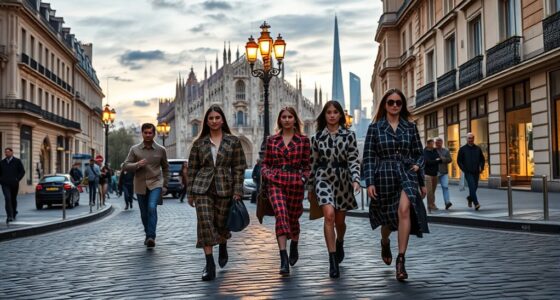Haute couture dresses cost as much as a car because of the incredible craftsmanship involved, with skilled artisans spending hours or weeks hand-sewing intricate details, embellishments, and using rare, luxurious fabrics. Each gown is custom-designed for a client, ensuring exclusivity and perfect fit, while limited production adds to scarcity. High-end fashion houses also invest heavily in branding, fashion shows, and marketing. Curious about what makes these gowns so pricey? Keep exploring to find out more.
Key Takeaways
- The extensive labor, skilled craftsmanship, and hundreds of hours required to create each gown inflate costs comparable to luxury cars.
- Use of rare, high-quality materials and exclusive fabrics significantly increases production expenses.
- Customization and unique designs for each client involve multiple fittings and personalized attention, adding to the price.
- Limited production and exclusivity elevate the value, making these dresses as rare and desirable as luxury vehicles.
- The prestige, brand heritage, and artistic craftsmanship behind haute couture contribute to its high price, similar to premium automobiles.
The Art of Handcraftsmanship and Detailing

The art of handcraftsmanship and detailing is what truly elevates haute couture dresses from ordinary to extraordinary. Unlike mass production and fast fashion, each haute couture piece involves meticulous hand-sewn details that require skill and patience. You won’t find these dresses made on assembly lines or churned out rapidly; instead, artisans dedicate hours, sometimes days, perfecting every stitch, embroidery, and embellishment. The high level of craftsmanship involved ensures that each dress is a work of art, with a distinct character and personality. This level of artistry not only demands exceptional skill but also embodies a tradition of precision and artistry. It’s this dedication to craftsmanship that justifies the high costs and makes these dresses stand apart from the mass-produced, fleeting trends of fast fashion. Additionally, the exclusive nature of haute couture means that each piece is often customized, adding to the exclusivity and high price tag. The use of specialized techniques further elevates the uniqueness and complexity of each creation, contributing to their high value.
Exclusive Materials and Rare Fabrics
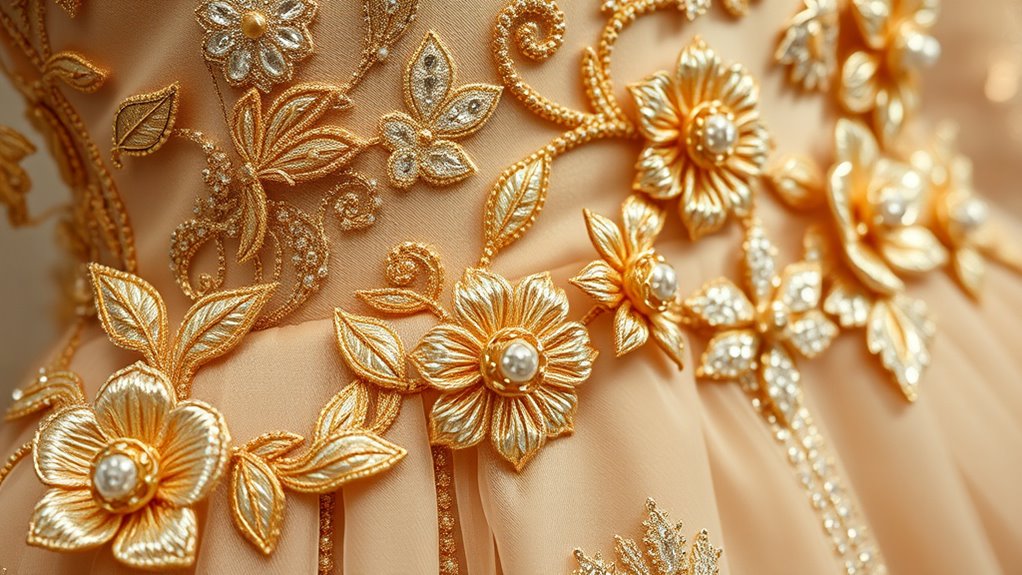
Have you ever wondered what makes haute couture dresses so uniquely luxurious? It’s the exclusive materials and rare fabrics chosen with precision, elevating each piece beyond ordinary fashion. Luxury branding plays a significant role here, as designers select only the finest silks, feathers, and embroidered textiles that are difficult to source and incredibly costly. These rare fabrics often involve lengthy production processes and limited availability, which drives up the price. Additionally, the sourcing of materials can be a lengthy and costly process, involving specialized craftsmanship and environmentally sustainable practices that add to the expense. The emphasis on ethical sourcing ensures that these materials are obtained responsibly, further increasing their value and appeal. Carefully curated material selection not only enhances the aesthetic appeal but also reflects the designer’s commitment to quality and sustainability, making each piece even more exclusive. Furthermore, the artisanal techniques used in creating these fabrics contribute significantly to their high cost, as they require skilled craftsmanship passed down through generations. Celebrity endorsements further amplify their desirability, as high-profile figures are often seen wearing garments crafted from these opulent materials. This combination of scarce, high-quality fabrics and strategic branding creates a sense of exclusivity and prestige, making each haute couture dress a true symbol of luxury that commands top dollar. Additionally, facilitating collaboration among artisans and designers ensures that each piece embodies exceptional craftsmanship and attention to detail, further elevating its value.
Customization and Unique Design Process
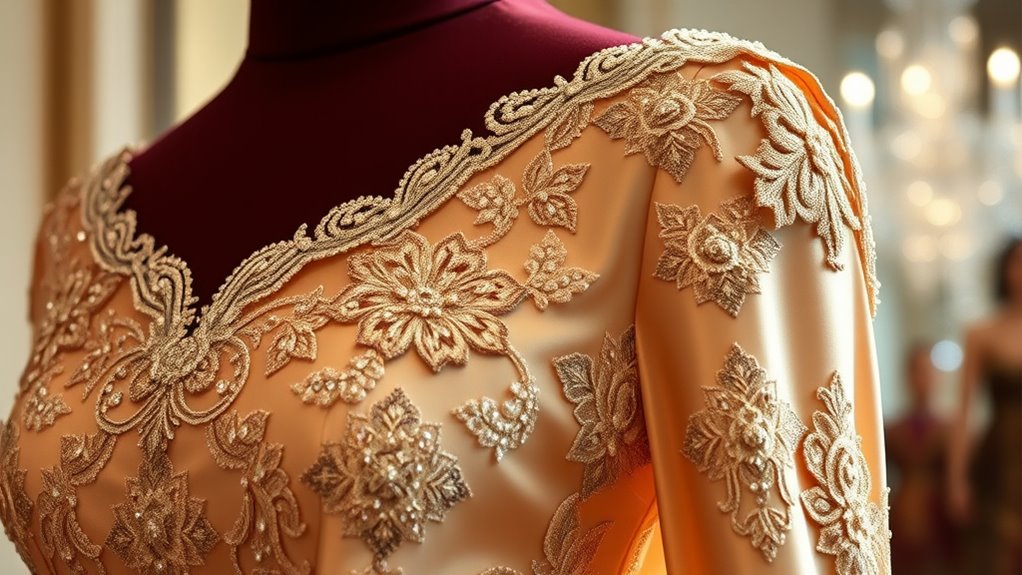
Ever wonder what truly sets haute couture dresses apart? It’s the level of customization and the unique design process tailored specifically for each client. Unlike mass production, where garments are made quickly and uniformly for the mass market, haute couture involves meticulous handcrafting and personalized details. You work closely with designers to create a one-of-a-kind piece that reflects your style and personality. Every stitch, fabric choice, and embellishment is carefully considered, often requiring multiple fittings. This bespoke approach demands time, skill, and artistry, ensuring no two dresses are exactly alike. The emphasis on individual craftsmanship drives up costs, but it also guarantees exclusivity and a perfect fit that mass-produced garments simply can’t match. Additionally, luxury craftsmanship ensures that each gown is a true work of art, further elevating its value and uniqueness.
The Role of High-End Fashion Houses
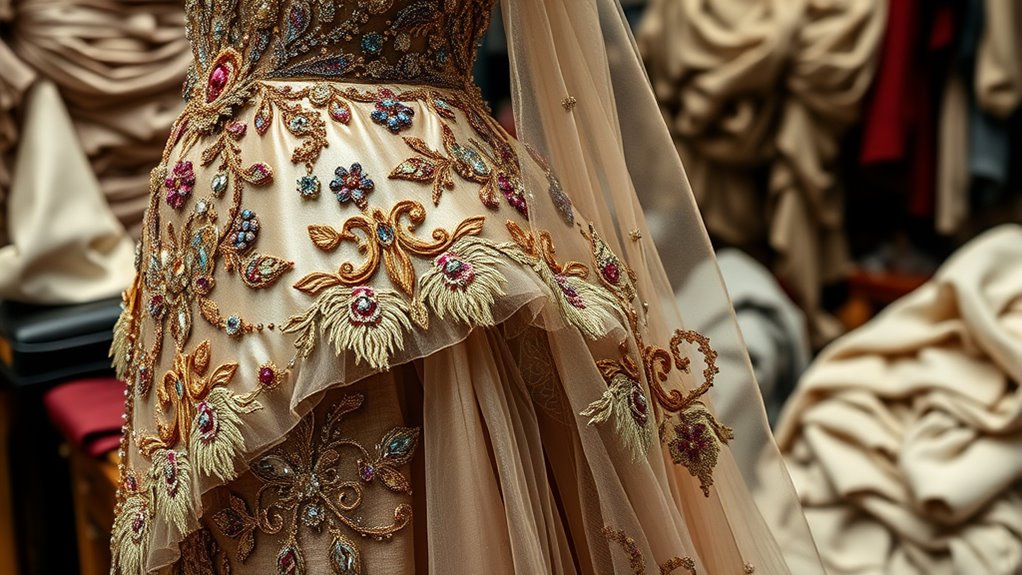
High-end fashion houses play a pivotal role in defining and elevating the standards of haute couture. They focus on craftsmanship, exclusivity, and artistry, which sharply contrast with mass market appeal and fast fashion. These houses invest heavily in skilled artisans, rare materials, and meticulous detail, making each piece a work of art. They set trends that influence the entire industry while maintaining their elite status. The table below highlights how their approach differs from mainstream fashion:
| Aspect | High-End Fashion Houses | Fast Fashion & Mass Market |
|---|---|---|
| Production Volume | Very limited | High volume |
| Material Quality | Premium fabrics | Cost-effective fabrics |
| Design Uniqueness | One-of-a-kind | Repetitive, trend-based |
| Price Point | Very high | Affordable |
| Customer Focus | Exclusive clientele | Broad consumer base |
This exclusivity drives up costs, reinforcing their prestige and desirability. Additionally, the artisanal craftsmanship involved in creating these garments further elevates their value and cost. The emphasis on timeless design ensures that haute couture remains desirable over trends, justifying their premium pricing. The use of rare materials not only enhances the uniqueness but also significantly increases production costs, which are reflected in the final price. Moreover, the commitment to sustainable practices is increasingly influencing high-end fashion, often leading to higher costs. The dedication to ethical sourcing also contributes to the elevated expenses associated with haute couture.
Limited Production and Scarcity
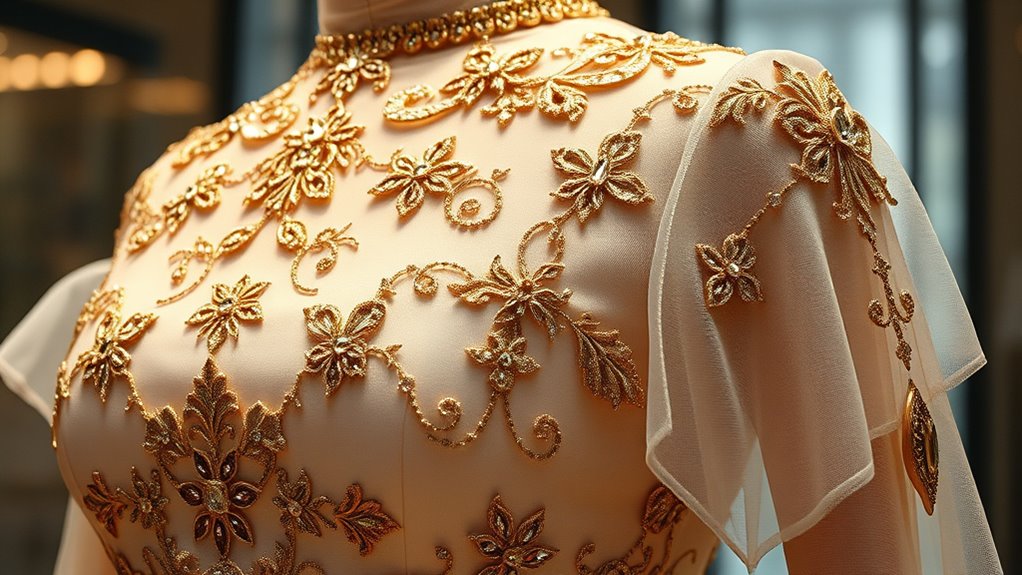
Because haute couture pieces are produced in limited quantities, each design feels truly one-of-a-kind. You’re often presented with exclusive materials and intricate craftsmanship that can’t be found elsewhere. This scarcity drives up the value and makes each dress a highly sought-after work of art. Additionally, the leadership skills involved in managing bespoke production processes ensure that each piece meets the highest standards of quality and exclusivity. The limited production also means that artisans and designers devote extensive time and expertise to each garment, further elevating its cost and prestige. Moreover, the complexity of integrating security measures to protect intellectual property adds to the overall production costs, emphasizing the exclusivity of haute couture. Implementing proper inventory management practices helps maintain the balance between supply and demand, reinforcing the rarity of these garments. Incorporating market demand for unique, high-end fashion further influences pricing, making these dresses comparable to luxury items like cars.
Exclusive Designs and Materials
Limited production and scarcity play a pivotal role in elevating the exclusivity of haute couture designs. When you own a dress crafted from rare, luxurious materials—like bespoke fabrics or hand-selected textiles—you’re investing in something truly unique. Designers often incorporate luxury accessories into their creations, adding further rarity and value. Celebrity endorsements also boost desirability, as high-profile figures showcase these exclusive pieces, making them even more coveted. Because these designs are produced in limited quantities, their scarcity drives up demand and price. You’re paying not just for the craftsmanship, but for the rarity and status associated with owning something few others can access. This combination of exclusive materials, limited runs, and celebrity appeal cements the high cost of haute couture dresses. Additionally, the international market for these garments influences their pricing, as global demand for luxury fashion continues to grow.
Handcrafted Precision and Detail
The intricate craftsmanship behind each haute couture dress is what truly sets it apart. Unlike mass market appeal and mass production, these dresses are crafted with painstaking attention to detail, often taking dozens of hours or even weeks to complete. Every stitch, bead, and embroidery is done by hand, ensuring perfection and uniqueness. The limited production adds to their scarcity, making each piece a rare work of art. Unlike factory-made garments, haute couture dresses prioritize handcrafted precision, which drives up labor costs and adds exclusivity. You’re paying not just for the materials but for the skill, patience, and artistry that transform luxurious fabrics into wearable masterpieces. This level of detail makes these dresses more than fashion; they’re collectible, one-of-a-kind creations.
Skilled Artisans Behind Every Stitch
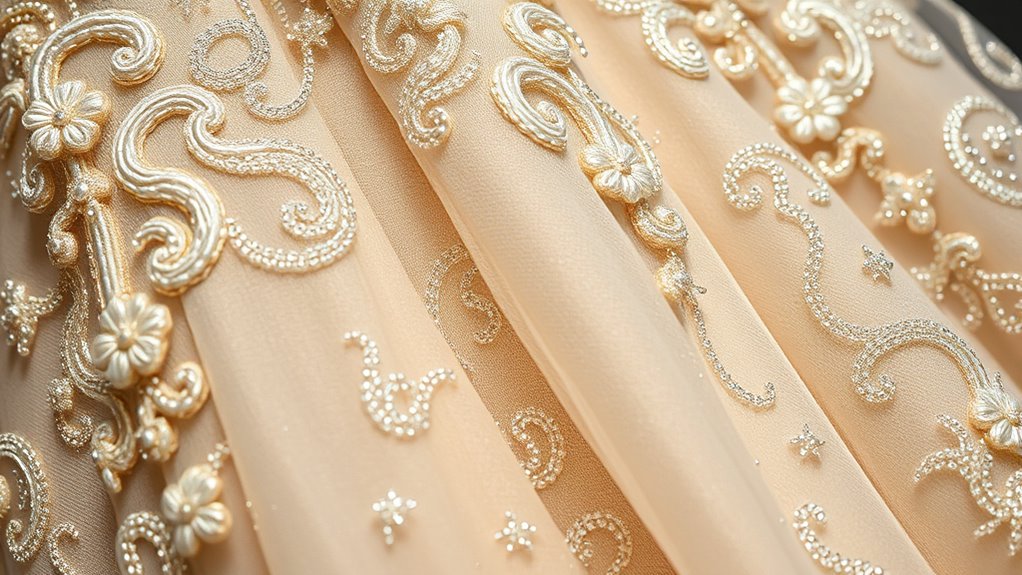
Behind every haute couture dress, skilled artisans dedicate hours of meticulous craftsmanship. These artisans are the backbone of luxury branding, ensuring each stitch reflects perfection and exclusivity. Their expertise transforms fabric into wearable art, often working with rare materials that demand precision. You’ll notice how their attention to detail elevates the garment’s value, making it more than just clothing—it’s a statement of luxury. Celebrity endorsements further highlight the importance of these artisans, as designers showcase their work on the world’s biggest stars. Their hands craft every element, from intricate embroidery to delicate beadwork, justifying the high cost. You’re paying for the mastery and dedication that turns fabric into a symbol of status, craftsmanship, and timeless elegance.
Time Investment and Labor Intensity

You’ll notice that handcrafted detailing techniques require countless hours of careful work. The extended creating process means skilled artisans spend days or even weeks perfecting each dress. This intense labor investment considerably drives up the overall cost of haute couture.
Handcrafted Detailing Techniques
Handcrafted detailing techniques in haute couture demand immense time and labor, often taking hundreds of hours to complete a single gown. You invest significant effort in fabric sourcing, selecting only the finest textiles that enhance each design’s exclusivity. Every stitch and embellishment requires meticulous attention, with artisans carefully applying embroidery, beadwork, and appliqué by hand. These skilled craftsmen dedicate hours to perfecting each detail, knowing that even the smallest imperfection can compromise the piece’s value. Additionally, the runway staging process influences how these details are presented, demanding precise finishing touches that showcase craftsmanship. This combination of fabric selection, intricate detailing, and presentation elevates the gown beyond clothing—transforming it into wearable art. Your commitment to perfection justifies the high costs associated with haute couture.
Extended Creating Process
The creation of a haute couture gown is a lengthy, labor-intensive process that can span several hundred hours. Unlike mass production or fast fashion, each dress is crafted with meticulous attention to detail, often involving months of work. Designers and artisans carefully select fabrics, develop unique patterns, and execute intricate hand-sewn techniques. This extended process guarantees every element aligns perfectly, from fabric cutting to final finishing. While mass-produced garments are made quickly to meet high demand, haute couture prioritizes quality, exclusivity, and artistry. This laborious approach demands skilled craftsmanship, often requiring dozens of artisans working simultaneously. The time investment is significant, and every stitch reflects dedication, making these dresses far more than just clothing—they are wearable works of art.
Brand Heritage and Prestige
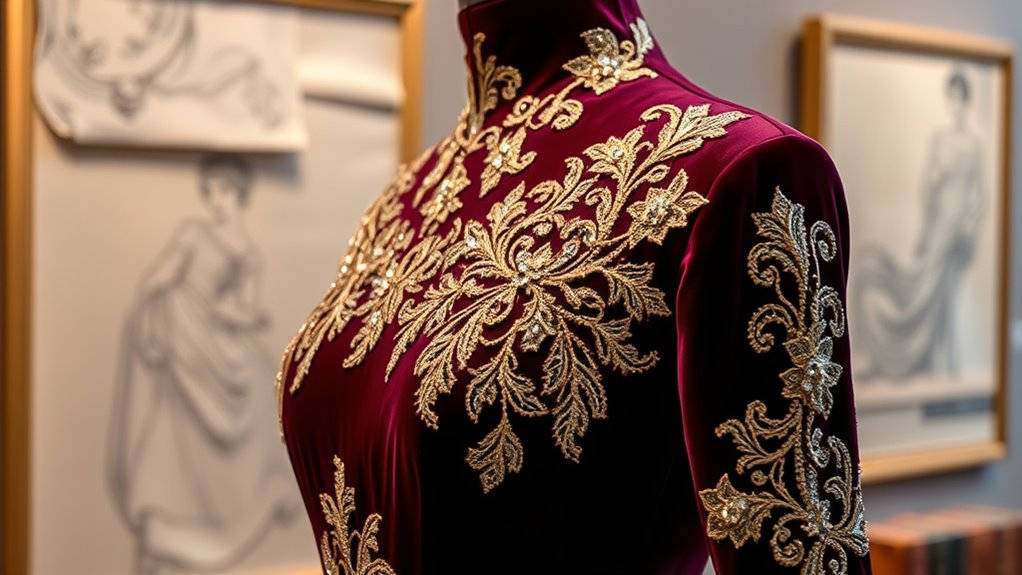
Brand heritage and prestige considerably influence the high costs of haute couture dresses, as they embody decades of craftsmanship, innovation, and reputation. When you invest in a piece from a legendary house, you’re buying more than fabric—you’re embracing a legacy of luxury branding that commands admiration worldwide. The brand’s history adds exclusivity, making each dress a symbol of status. Celebrity endorsements further elevate this perception, linking the designer to glamour and influence.
Investing in haute couture means embracing centuries of craftsmanship, exclusivity, and celebrity glamour that elevate each piece to art and status.
Feel the emotion when you realize:
- You’re wearing a piece rooted in centuries of tradition
- Your dress is backed by a name that shapes fashion history
- You’re part of an elite circle, associated with fame and sophistication
The Cost of Fashion Shows and Marketing
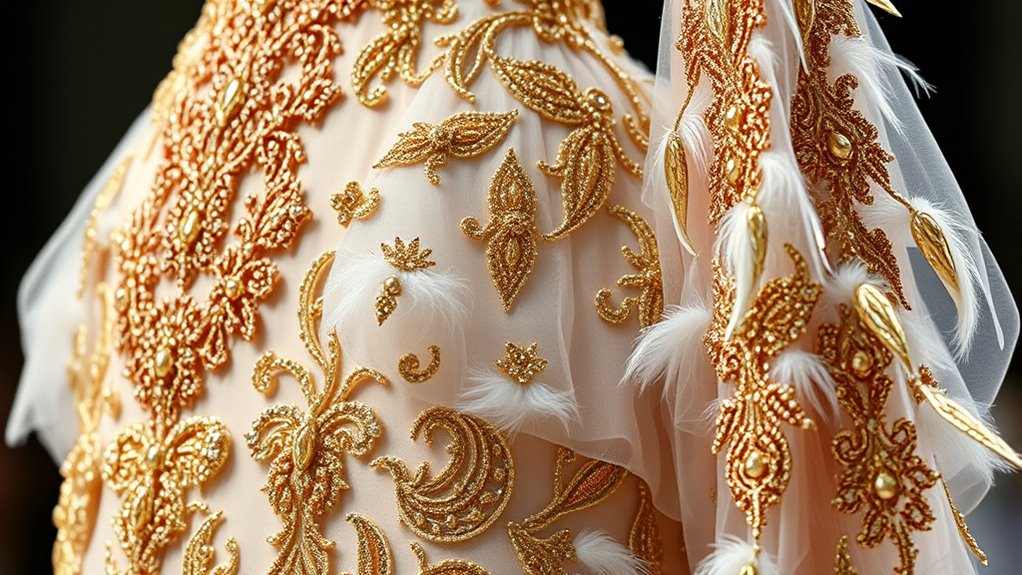
Hosting a high-profile fashion show and executing effective marketing campaigns can considerably drive up the cost of haute couture dresses. You invest heavily in runway choreography to create a enthralling presentation, ensuring each movement highlights your designs. Fashion show logistics, including venue, models, and staff, add to expenses, often requiring meticulous planning. Marketing efforts, such as promotional videos and invitations, also inflate costs to reach elite audiences. Here’s a breakdown of key elements:
| Element | Description | Typical Cost Impact |
|---|---|---|
| Runway Choreography | Creating dynamic, memorable routines | High |
| Venue & Setup | Exclusive locations & elaborate staging | Very High |
| Models & Staff | Top-tier talent and assistants | Significant |
| Marketing Campaigns | Promotions and influencer collaborations | Substantial |
Investment Value and Collector’s Appeal

Investing in a haute couture dress often goes beyond its immediate wearability, as many pieces appreciate in value and become coveted collector’s items over time. The vintage appeal of these dresses enhances their desirability, making them timeless treasures. You might find that their resale value increases, especially if the design or designer gains historical significance. Owning such a piece means you’re not just wearing fashion—you’re holding onto art with lasting worth. These dresses can evoke strong emotions, connecting you to a glamorous past.
- A rare, iconic design that appreciates in value over decades
- The allure of owning a piece of fashion history
- The potential for a high resale value as a collector’s item
Frequently Asked Questions
How Does the Reputation of a Fashion House Influence Dress Prices?
Your perception of a fashion house’s reputation profoundly impacts dress prices. When a brand is known for prestige and mastery of craftsmanship, you’re willing to pay more for their creations. Their reputation assures you of exclusivity, quality, and artistry, which justifies higher costs. As a result, the more renowned the brand, the more you value their craftsmanship mastery, leading to elevated prices for their haute couture dresses.
What Role Do Celebrity Endorsements Play in Couture Pricing?
Like a modern-day Aphrodite, celebrity influence markedly boosts couture pricing. When stars endorse a designer, their endorsement value elevates the dress’s allure, making it more desirable and exclusive. This association creates a perception of luxury and status, driving up demand. Your perception of the dress’s worth becomes intertwined with the celebrity’s glamour, making the dress more than fabric — it’s a symbol of prestige that commands a premium price.
Are Haute Couture Dresses Ever Sold at Auction for Profit?
Yes, haute couture dresses are sometimes sold at auction for profit. You might find vintage auctions showcasing iconic pieces, which can fetch high prices due to their rarity and designer pedigree. In resale markets, collectors and enthusiasts often buy couture dresses to resell later at a premium. If you’re interested, monitor vintage auctions and resale platforms, as they offer opportunities to purchase or sell couture for profit.
How Do Seasonal Collections Impact the Cost of Couture Pieces?
Seasonal collections impact the cost of couture pieces because designers invest heavily in fabric sourcing and craftsmanship techniques each season. When you choose a couture dress, you’re paying for exclusive fabrics and meticulous handwork, which vary with seasonal trends. Limited availability, unique designs, and high-quality materials make these pieces more expensive, reflecting the craftsmanship and effort that go into creating each one, often aligning with the luxury pricing of a car.
What Are the Environmental Impacts of Producing Luxury Couture?
Producing luxury couture markedly impacts the environment, especially if sustainable materials aren’t used. You might not realize it, but the high carbon footprint from sourcing rare fabrics and handmade craftsmanship adds up. Choosing sustainable materials can reduce this impact, but many couture houses still prioritize exclusivity over eco-friendliness. As a result, your love for luxury fashion can contribute to environmental harm unless brands embrace greener practices.
Conclusion
So, next time you wonder why haute couture dresses cost as much as a luxury car, remember it’s because you’re paying for artistry, rare materials, and countless hours of expert craftsmanship. It’s not just clothing—it’s a masterpiece that embodies centuries of tradition and exclusivity. When you consider the level of detail and dedication, it’s clear these dresses are worth more than gold, making them truly the crown jewels of fashion.



